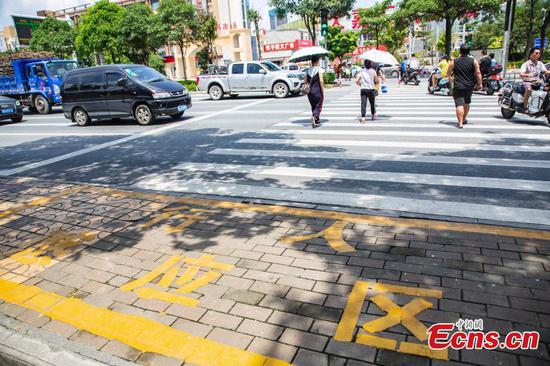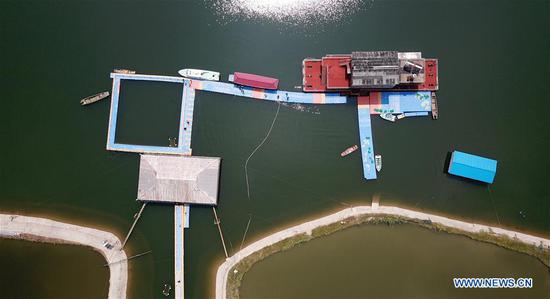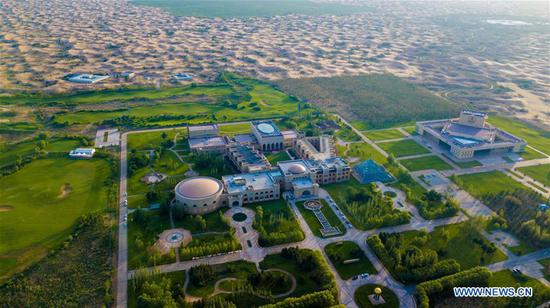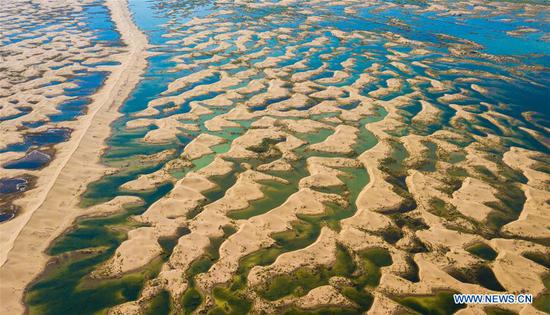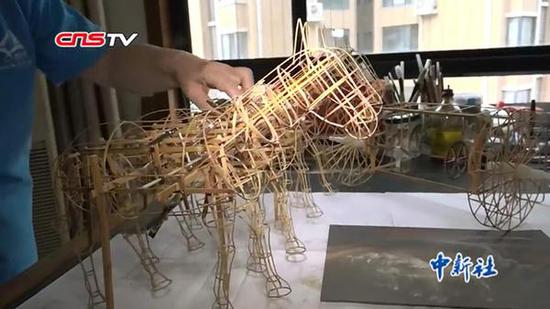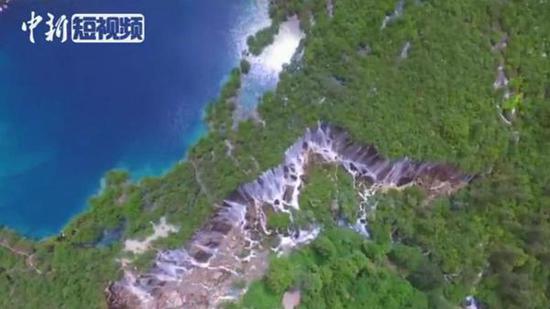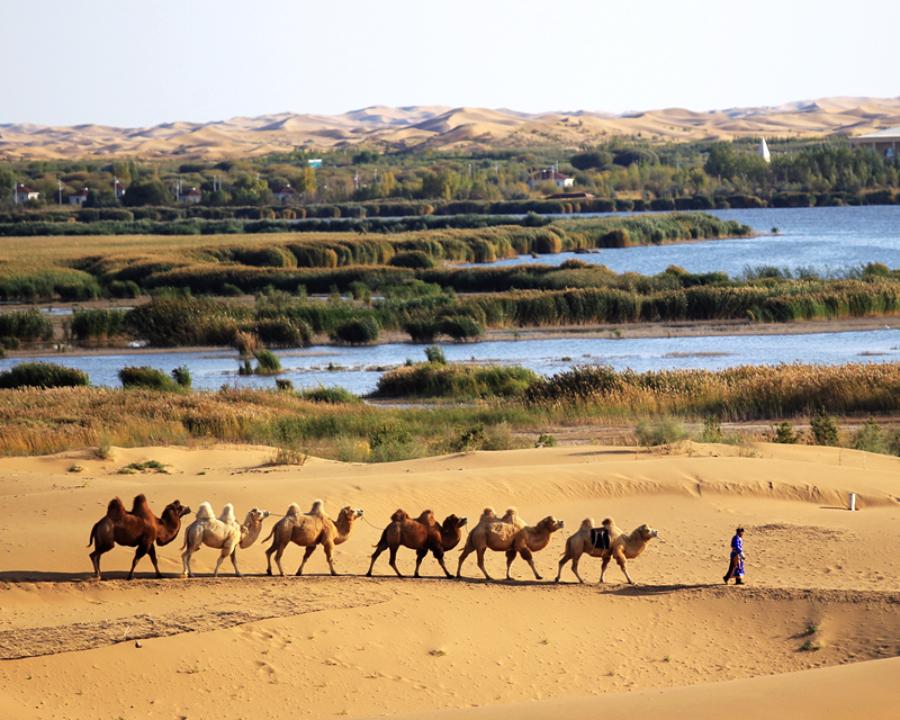
Camel riding has become a popular activity for tourists to the Kubuqi Desert, Inner Mongolia autonomous region. (Photo/China Daily)
With sweat dripping from his brow and pooling in his lower back, Urgendalai dug holes in the desert. His muscular arms moved constantly, driving through to the tough soil below and leaving his feet and ankles covered in sand.
The desert sand lacked life, but Urgendalai put a few saplings into the holes and watered them. "They're weak and frail, but the rain will come and they should survive. Now, life has a chance in the Kubuqi," he said.
After more than three decades of effort and innovation, the process of desertification has been reversed in about one-third of the Kubuqi Desert-China's seventh largest at 18,600 square kilometers-in the Inner Mongolia autonomous region in the north of the country.
Though centuries of animal grazing had denuded the area of almost all vegetation and the local population of 100,000-plus people existed in isolated poverty, the recent transformation of once-barren dunes into lush oases offers a solution to desertification worldwide.
China has about 2.6 million sq km of deserts and a further 1.7 million sq km of desertified land (soil that is gradually becoming more arid), meaning that the country is one of the most severely afflicted in the world. Combined, these areas account for about 10 percent of the global total, according to statistics provided by the State Forestry Administration last year.
At the end of the 20th century, China's deserts were expanding at a combined annual rate of 10,400 sq km. Now, they are shrinking at a rate of 2,424 sq km per year, while deserts and desertified areas worldwide are expanding by 70,000 sq km annually, the statistics showed.
"Deserts should not be seen as a problem, but as an opportunity for change. Taking care of the desert and making it greener can lift people out of poverty, provide prosperity and help to develop areas," said Wang Yujie, deputy director of the China National Sand Control and Desert Industry Society.
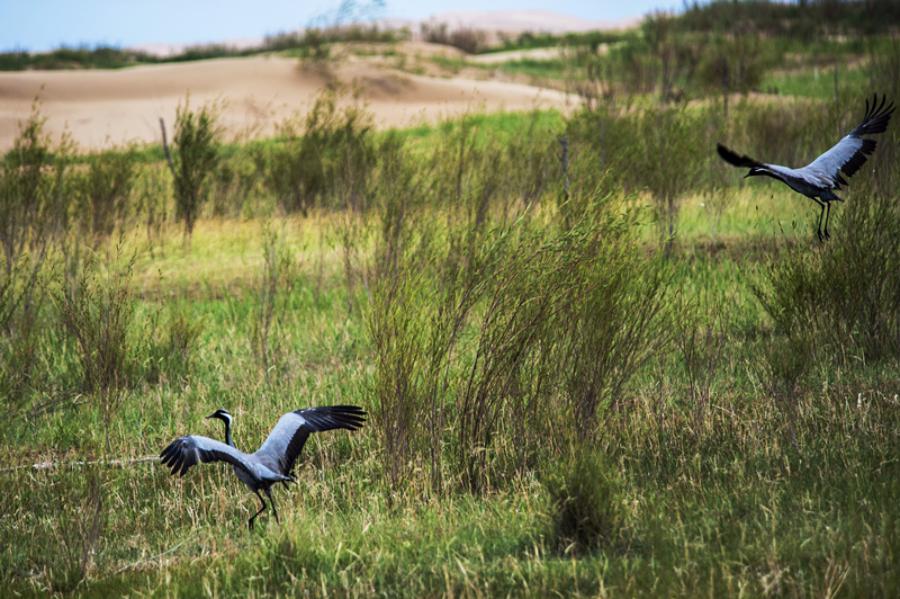
The oasis in desert attracts cranes to rest. (Photo/China Daily)
The Kubuqi is the desert closest to Beijing, just 800 kilometers away, and was once a major source of sandstorms carried by the wind to the Beijing-Tianjin-Hebei region.
Farmers and herdsmen in the desert were plagued by violent sandstorms, which caused serious shortages of water and electricity, resulting in poor infrastructure and a lack of roads. The local people could only cultivate a few hardy plants that could survive in sandy soil, so their lives were hard and poor.
In 1986, when Urgendalai was 18 years old, the land was too infertile to farm or use for grazing, so the people flocked to dig up wild licorice to sell. The practice exhausted the already barren land and the loss of the root systems resulted in a lack of soil integrity. That saw the desert expand and extinguish all hope of making a living from farming.
"I saw camels die from starvation and cattle and sheep kneeling down motionless because they were so thirsty. I was terrified by the cruelty of the desert and ashamed of what we had done to our home," he said.
New priorities
In the 1990s, the Ordos government prioritized the development of plant cultivation to tackle environmental degradation, boost livelihoods and safeguard homes in tandem with efforts to research and develop a range of sand-control technologies.
In 1997, the government decided to build a 115-km-long highway through the desert to allow more convenient transportation of water and other resources, and the construction of an electricity network. The move enabled the locals to undertake mass planting of trees, grass and herbs.
Elion Resources Group, once a salt miner and refiner but now a green technology and finance company, joined the construction program as a way of ensuring its own survival. At the time, the salt it produced had to be transferred to the nearest railway station via an indirect 350-km-long route because there was no road through the desert. The distance was just 65 km as the crow flies.
"Frequent sandstorms swallowed a road we subsequently built, which meant all our endeavors had been in vain. It became clear that the desert had to be tamed, but that would only be possible if the local community became involved, said Wang Wenbiao, Elion's chairman.
At first, the company paid local farmers about 30 yuan ($4.40) a day to plant trees in the desert. However, the locals didn't have a financial stake in the plants' survival so most of the saplings died. When Elion began offering bonuses for trees that lasted the distance, the survival rate soared.
Gao Maohu, a 58-year-old farmer in Hangjinqi, used to travel to nearby cities to work temporary jobs because he was unable to grow enough crops on his 1.3 hectares of saline-alkali soil to feed his family. In 2000, he joined Elion's tree cultivation team without hesitation when he heard he could make money by planting saplings in his hometown.
"I couldn't ask for a better job. I make a good salary and I don't have to leave my family. I have tried every method to keep the saplings alive, and there were countless trials and errors along the way," he said.
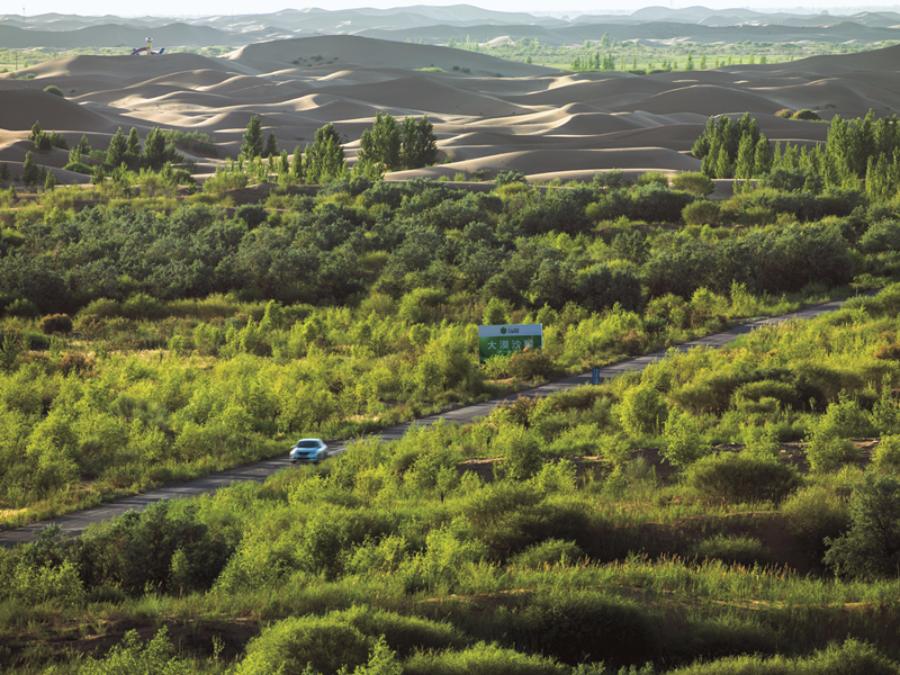
Construction of the first road to cross the desert took two years to complete. (Photo/China Daily)
With the help of Elion's technical experts, Gao developed a method of using high-pressure water jets to drill holes in the sand, reducing the planting time to about 10 seconds per tree from an average of 10 minutes and raising the survival rate to more than 80 percent. Now his land is lush with drought-resistant trees and bushes.
To provide multiple ways of making the desert green, fertile and profitable, farmers are also encouraged to grow licorice because it can withstand drought and the nighttime cold in the desert. Moreover, the roots help to keep the soil in place and make it fertile, enabling crops such as watermelons and tomatoes to be grown. After four years, the roots can be harvested and sold for large sums as an important ingredient of traditional Chinese medicines.
"The licorice is encouraged to grow horizontally instead of vertically as in other places. Thus, it can quickly cover a square meter of land, raising greening efficiency by 10 times. So far, the area planted with licorice in the Kubuqi has reached 1,466 sq km," said Zhang Bo, deputy general manager of Elion Ecological Health Co, an Elion subsidiary.
Technological advances
Modern technology has also been employed to tame and harness the Kubuqi, which sees more than 3,000 hours of sunshine every year, making it an ideal place to install solar power farms.
Photovoltaic generators have been installed to produce electricity, while grass grown in the shaded spaces underneath the solar panels is used to feed livestock, such as sheep, geese and chickens.
According to a report published last year by the UN Environmental Programme, more than 6,250 sq km of the Kubuqi have been reclaimed in the past 30 years, while 14.5 million metric tons of carbon were removed from the atmosphere. The rainfall level soared to 456 mm in 2016, compared with about 100 mm in 1988, and the annual number of sandstorms fell from 50 to just one in the same period.

In the 1980s, camels were the only form of transportation for people in the Kubuqi. (Photo/China Daily)
Statistics provided by the local government show that the annual per capita net income of the 100,000 local farmers and herdsmen reached 14,000 yuan in 2016.d
In his capacity as general secretary of the Communist Party of China, Xi Jinping delivered a report to the CPC 19th National Congress in October in which he pledged to establish an environmental governance system in which the government will take the lead, while business will assume the main responsibilities and social organizations and the public will participate.
Tu Zhifang, chief engineer of the National Bureau to Combat Desertification, said: "In the fight against desertification, we not only need the government to have the vision to regulate the market, but we also need the private sector to bring innovative ideas and create jobs. Most important, we need people to actively participate. We have all three factors in the Kubuqi, which is why it is being turned into an oasis."
In recent years, the Ulanbuh Desert in Inner Mongolia, the Taklamakan Desert in the Xinjiang Uygur autonomous region, the Tengger Desert in Gansu province, cold alpine areas in the Tibet autonomous region and desertified regions in the provinces of Qinghai and Hebei have all followed the Kubuqi's lead and made significant contributions to eco-restoration and poverty alleviation.
The lessons learned during the successful efforts in the Kubuqi, especially those related to eco-restoration and the development of eco-economies, offer solutions to the problem across the globe.
Ao Baoping, general manager of Elion Ecological Health, said the company's experts travelled to several African countries last year, including Ethiopia, Ghana and Algeria, and countries in the Middle East, including Saudi Arabia, which are all experiencing severe desertification.
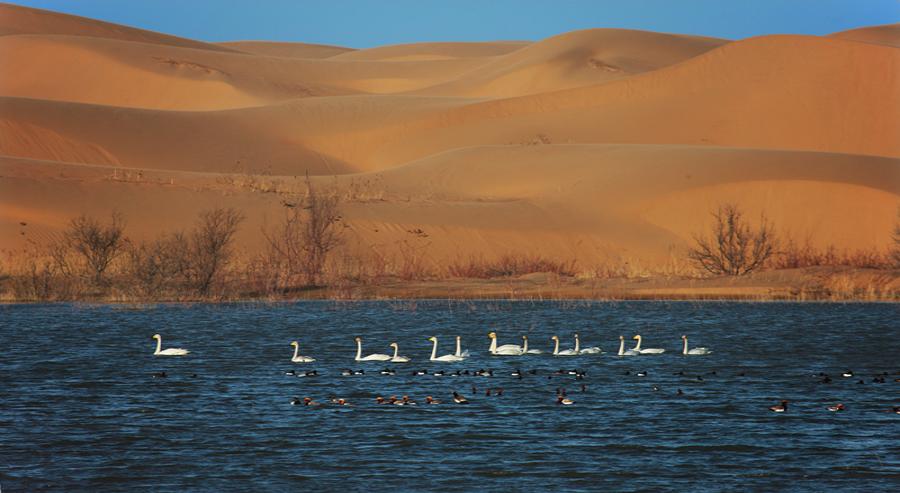
Birds swim at a desert lake in Kubuqi. (Photo/China Daily)
"We adjusted the Kubuqi model-the experience we gained and the technologies we developed over decades of anti-desertification work-to local conditions to provide a plan that will really take effect as it did in the Kubuqi," he said.
"Our desertification control team has also established a center to train experts from across the world and explain how the most effective control methods work in the Kubuqi. We want to offer whatever we can to help create a greener planet," he added.
Urgendalai, 50 years old and a father of five, said he will only stop planting trees when he is unable to hold a spade.
"I know how the desert can hurt, and I won't let it hurt my children again," he said.











